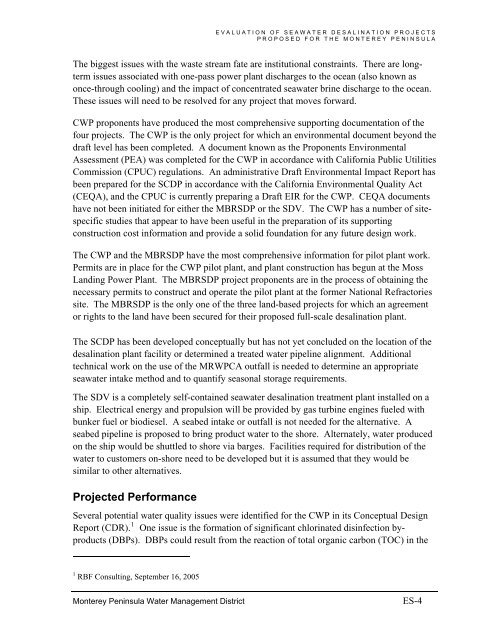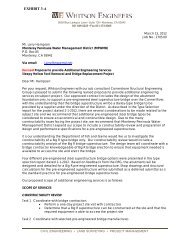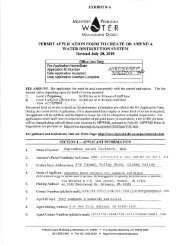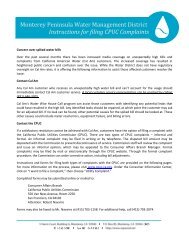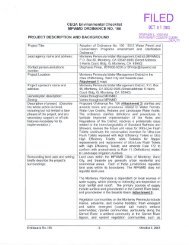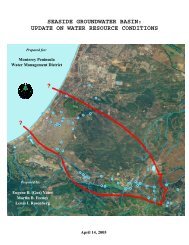FINAL REPORT Evaluation of Seawater Desalination Projects ...
FINAL REPORT Evaluation of Seawater Desalination Projects ...
FINAL REPORT Evaluation of Seawater Desalination Projects ...
You also want an ePaper? Increase the reach of your titles
YUMPU automatically turns print PDFs into web optimized ePapers that Google loves.
EVALUATION OF SEAWATER DESALINATION PROJECTS<br />
PROPOSED FOR THE MONTEREY PENINSULA<br />
The biggest issues with the waste stream fate are institutional constraints. There are longterm<br />
issues associated with one-pass power plant discharges to the ocean (also known as<br />
once-through cooling) and the impact <strong>of</strong> concentrated seawater brine discharge to the ocean.<br />
These issues will need to be resolved for any project that moves forward.<br />
CWP proponents have produced the most comprehensive supporting documentation <strong>of</strong> the<br />
four projects. The CWP is the only project for which an environmental document beyond the<br />
draft level has been completed. A document known as the Proponents Environmental<br />
Assessment (PEA) was completed for the CWP in accordance with California Public Utilities<br />
Commission (CPUC) regulations. An administrative Draft Environmental Impact Report has<br />
been prepared for the SCDP in accordance with the California Environmental Quality Act<br />
(CEQA), and the CPUC is currently preparing a Draft EIR for the CWP. CEQA documents<br />
have not been initiated for either the MBRSDP or the SDV. The CWP has a number <strong>of</strong> sitespecific<br />
studies that appear to have been useful in the preparation <strong>of</strong> its supporting<br />
construction cost information and provide a solid foundation for any future design work.<br />
The CWP and the MBRSDP have the most comprehensive information for pilot plant work.<br />
Permits are in place for the CWP pilot plant, and plant construction has begun at the Moss<br />
Landing Power Plant. The MBRSDP project proponents are in the process <strong>of</strong> obtaining the<br />
necessary permits to construct and operate the pilot plant at the former National Refractories<br />
site. The MBRSDP is the only one <strong>of</strong> the three land-based projects for which an agreement<br />
or rights to the land have been secured for their proposed full-scale desalination plant.<br />
The SCDP has been developed conceptually but has not yet concluded on the location <strong>of</strong> the<br />
desalination plant facility or determined a treated water pipeline alignment. Additional<br />
technical work on the use <strong>of</strong> the MRWPCA outfall is needed to determine an appropriate<br />
seawater intake method and to quantify seasonal storage requirements.<br />
The SDV is a completely self-contained seawater desalination treatment plant installed on a<br />
ship. Electrical energy and propulsion will be provided by gas turbine engines fueled with<br />
bunker fuel or biodiesel. A seabed intake or outfall is not needed for the alternative. A<br />
seabed pipeline is proposed to bring product water to the shore. Alternately, water produced<br />
on the ship would be shuttled to shore via barges. Facilities required for distribution <strong>of</strong> the<br />
water to customers on-shore need to be developed but it is assumed that they would be<br />
similar to other alternatives.<br />
Projected Performance<br />
Several potential water quality issues were identified for the CWP in its Conceptual Design<br />
Report (CDR). 1 One issue is the formation <strong>of</strong> significant chlorinated disinfection byproducts<br />
(DBPs). DBPs could result from the reaction <strong>of</strong> total organic carbon (TOC) in the<br />
1 RBF Consulting, September 16, 2005<br />
Monterey Peninsula Water Management District<br />
ES-4


